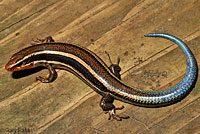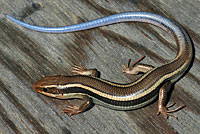Skinks in California - Plestiodon


| There are Two Species of Skinks Native to California |
||
1. Gilbert's Skinks - Plestiodon gilberti 2. Western Skinks - Plestiodon skiltonianus (The name of the genus of these lizards, Eumeces, was changed to Plestiodon in 2008. In a lot of the existing literature these lizards will be called Eumeces gilberti and Eueces skiltonianus.) Four subspecies of Gilbert's Skinks are found in California. Three subspecies of Western Skinks are found in California. |
||
| Appearance | ||
| Both species are small to medium-sized lizards with smooth, shiny skin. The scales are smooth shiny cycloid scales that are reinforced with bone. They are not rough and raised up like they are on some other kinds of lizards, such as alligator lizards. (Un-patterned juvenile alligator lizards are sometimes mistaken for skinks, especially the ground skink common in the East.) Adult Gilbert's Skinks are typically brownish with no pattern and no stripes and no color on the tail (however, some adults do retain some striping and some color on the tail.) Juvenile Gilbert's Skinks have bright blue tails in some areas, pink tails in other areas, and a combination of blue and pink or purple, in other areas. Adult Western Skinks have alternating dark and light stripes running from the head down the length of the body. Sometimes the adults will retain some blue coloring on the tail, and the stripes on some old adults are faded. Juvenile Western Skinks have bright blue tails, which generally fade with age. Some adults retain blue on the tail, others do not. |
||
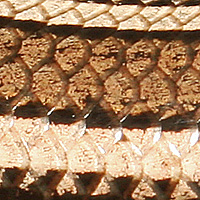 |
||
| Toothy Skinks, genus Plestiodon, have smooth shiny cycloid scales that are reinforced with bone. Plestiodon skiltonianus is shown here. |
||
| Habitat | ||
| These skinks are generally fond of moist habitats, including rocky areas in forests and near water, but they will often be found under rocks, bark, or woody debris in areas which get direct sunlight. Sometimes they will be seen moving around in leaf litter or in grass during daylight, but usually they are secretive and hide under surface objects. |
||
| Identification of Species | ||
Adults |
||
| Scale Count Differences | ||
A Western Skink usually has 7 supralabial scales and 4 enlarged nuchal scales. A Gilbert's Skink usually has 8 supralabial scales and 3 enlarged nuchal scales. (Powell, Collins, and Hooper 1998) This is not always the case, as you can see on the lizards three rows below. |
||
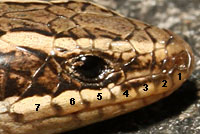 |
 |
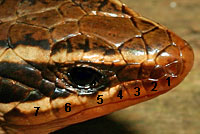 |
| Western Skink - Plestiodon skiltonianus - usually has 7 supralabial scales. | ||
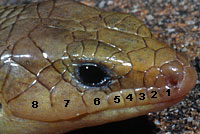 |
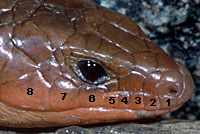 |
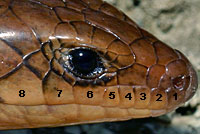 |
| Gilbert's Skink - Plestiodon gilberti - usually has 8 supralabial scales. |
||
| Aberrant supralabial scale counts. | ||
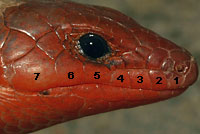 |
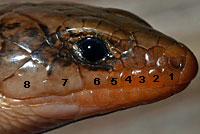 |
|
| Gilbert's Skink | Western Skink | |
| Juvenile Skinks in California |
||
 |
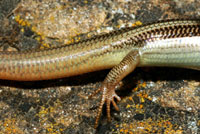 |
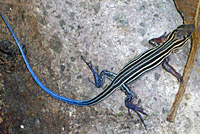 |
| Juvenile Gilbert's Skink Dark stripes on the sides of the tail do not extend far past the rear legs. Compare |
Be careful not to confuse juvenile Belding's Orange-throated Whiptails, like the one seen above, with juvenile skinks with blue tails. This whiptail has more light stripes on the back, and is thinner, with a longer and thinner tail than is found on a skink. | |
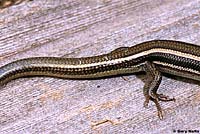 |
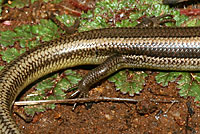 |
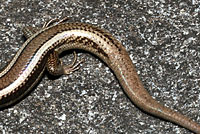 |
| Adult Western Skink Dark stripes on the sides of the tail extend far past the rear legs. Compare |
Beware that the side stripes of adult Western Skinks with tails that have been re-grown may not continue very far past the rear legs, as you can see here. |
|
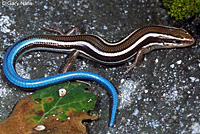 |
 |
 |
| Juvenile Western Skink with blue tail | Juvenile Gilbert's Skink with pink tail | Juvenile Gilbert's Skink with blue tail |
 |
 |
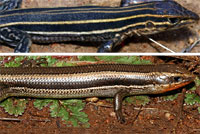 |
| Older juvenile Gilbert's Skink with a blue and pink tail |
Older juvenile Gilbert's Skink with reddish tail |
Skinks in Southern California can be confused with the Orange-throated whiptail, but the whiptail will have more light stripes and they are thinner. Click the picture above for a closer comparison. |
| Gilbert's Skinks - Plestiodon gilberti
|
||
 |
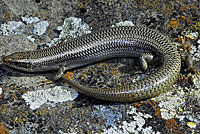 |
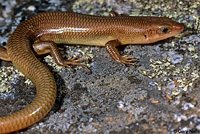 |
| Large adults with no distinct stripes. Often, the scales appear outlined with dark coloring. | ||
 |
 |
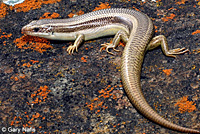 |
| Adult males in breeding condition develop bright red on the head and tail. This color fades after the breeding season is over. |
Adults in some areas retain faint stripes, but they are not as distinct as those of the Western Skink. | |
| Four subspecies of Gilbert's Skinks occur in California. The taxonomy of Gilbert's skinks is under revision, meaning that the names of the subspecies not be valid and will probably change in the near future. If you want to find which subspecies is found in your area, check the map below. Click on the name links for more pictures and information. |
||
Range |
||
 |
||
Orange: Variegated Skink - Plestiodon gilberti cancellosus Blue: Greater Brown Skink - Plestiodon gilberti gilberti Purple: Northern Brown Skink - Plestiodon gilberti placerensis Red: Western Red-tailed Skink - Plestiodon gilberti rubricaudatus Gray: Approximate intergrade areas |
||
| Western Skinks - Plestiodon skiltonianus
|
||
| Adults with blue on the tail. | ||
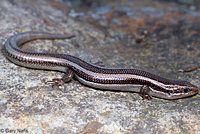 |
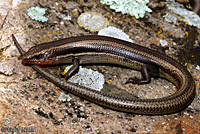 |
 |
| Adults with little or no blue on the tail. | ||
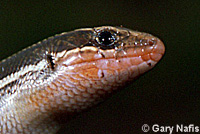 |
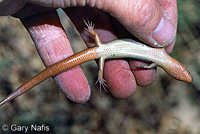 |
|
| Adults in breeding condition develop a reddish wash on the head, throat and tail, and sometimes on the side. This color fades after the breeding season is over. Two subspecies of Western Skinks are currently recognized. There is no easy way to tell them apart. In fact, some herpetologists do not believe that these subspecies are valid. If you want to find which subspecies is found in your area, check the map below. Click on the name links for more pictures and information. |
||
| Identifying Subspecies of Plestiodon skiltonianus | ||
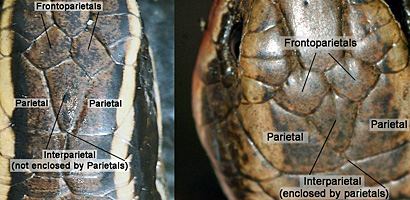 |
||
| Most Northwestern Skinks and Great Basin Skinks have on the top of their head an interparietal scale that is not enclosed by the parietal scales (Tanner 19571 ). Click on thumbnail to see a larger image. |
Most Coronado Island Skinks - P. s. interparietalis, have on the top of their head an interparietal scale that is enclosed by the parietals scales (Tanner 19571 ). |
|
| Characteristics of Subspecies of Plestiodon skiltonianus (from Tanner 1957) | ||
| P. s. interparietalis - Coronado Skink "Interparietal enclosed by the parietals in 80 per cent of the population. Stripes of the body pattern extended onto anterior half or more of tail." "The extension of the striped pattern on the tail is also seen in specimens of skiltonianus from the coastal ranges of California. However, specimens from north of San Diego County are generally less obviously striped on the tail and if so then with only an occasional one having the interparietal enclosed." "Diagnosis: this form is most closely related to typical skiltonianus with which it intergrades in San Diego and Riverside counties California. It is different to all other skiltonianus in having the interparietal reduced in size and enclosed posteriorly by the parietals, the medial and lateral dark stripes extend from the body to or beyond the middle of the tail." P. s. skiltonianus - Northwestern (Skilton's) Skink "Interparietal rarely enclosed by the parietals. Usually less than 10 per cent even in Los Angeles and San Bernardino Counties; and/or stripes of body pattern not extended on more than the base of the tail." P. s. utahensis - Great Basin Skink "Dorsolateral stripe occupying more than half of the second scale row and being nearly one half the diameter of the dark dorsal interspace. Dark stripe below lateral light stripe rarely present. Diameter of the dorsolateral stripe usually greater than the length of the first nuchal." [The light dorsolateral stripes are wider than in the two other species found in California.] |
||
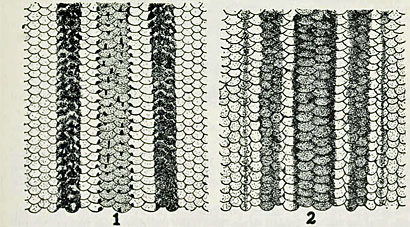 |
||
| Diagram the of dorsolateral stripes of P. s. utahensis (1) and P. s. skiltonianus (2) from Tanner, 1957. | ||
Range of P. skiltonianus |
||
 |
||
Blue: Coronado Skink - P. s. interparietalis Red: Northwestern Skink - P. s. skiltonianus Yellow: Great Basin Skink - P. s. utahensis Gray: Intergrade area |
||
Notes In a 2013 paper 1, Shedd and Richmond presented data that shows that the use of the side-stripe length to differentiate the two species is not accurate in all areas: "However, like the other characters used to differentiate P. skiltonianus and “gilberti,” we have detected notable variation in the extension of the lateral tail stripe in populations of both species, and below we present data that describe how the character fails to differentiate the two in certain parts of the range." ... "Because of the variability of this character across the range of the species complex, we consider it unreliable for distinguishing P. skiltonianus and “gilberti” over large portions of the range of the P. skiltonianus complex " They also point out areas in which a blue tail can indicate either species: ' “...gilberti” populations in the northern and central Sierra Nevada, as well as in scattered populations in the east Mojave Desert and the Panamint Mountains, are blue-tailed.' |
||
| References | ||
| 1 Jackson D. Shedd and Jonathan Q. Richmond. Herpetological Review, 2013, 44(3), 417–420. Conserved Ontogeny of Color Pattern Leads to the Misdiagnosis of Scincid Lizards of the Plestiodon skiltonianus Species Complex © 2013 by Society for the Study of Amphibians and Reptiles) Stebbins, Robert C., and McGinnis, Samuel M. Field Guide to Amphibians and Reptiles of California: Revised Edition (California Natural History Guides) University of California Press, 2012. Stebbins, Robert C. A Field Guide to Western Reptiles and Amphibians. 3rd Edition. Houghton Mifflin Company, 2003. 2 Robert Powell, Joseph T. Collins, and Errol D. Hooper, Jr. A Key to Amphibians and Reptiles of the Continental United States and Canada. © 1998 by the University Press of Kansas. Smith, Hobart M. Handbook of Lizards, Lizards of the United States and of Canada. Cornell University Press, 1946. Jones, Lawrence, Rob Lovich, editors. Lizards of the American Southwest: A Photographic Field Guide. Rio Nuevo Publishers, 2009. Tanner, Wilmer W. A taxonomic and ecological study of the western skink (Eumeces skiltonianus). Great Basin Naturalist 17:59-94 1957. |
||
Return to the Top
© 2000 -

